Contact-Level Intent: How to Uncover Prospect Pain Points & Boost Conversions

What if you could speak directly to your prospects at the exact moment they’re most interested in your product or service? Would your conversion rates skyrocket?
According to companies like StarTree, who achieved a 3x conversion rate boost in pipeline generation, and ProfitWell, who increased enterprise deals won by 111%, the answer is yes!
No, it's not magic.
It's the result of marketing and sales using contact-level intent to understand prospect motivations on a level that traditional methods simply can't match.
If you’re curious about how to achieve similar results, keep reading.
We’ll explain contact-level intent, why it’s the new standard for marketing and sales teams, and how to use these buying intent signals to grow pipeline and revenue.
What are buying intent signals?
Before we jump into contact-level intent, it’s important to understand the general concept of buying intent signals.
If this isn’t new to you, feel free to skip this section.
Buying intent signals are indications that someone is researching or planning to buy a product or service.
These signals can be either direct or indirect:
- Direct intent signals are clear and explicit actions that show someone is interested in making a purchase.
- Indirect intent signals are subtle hints that indicate someone may be interested in making a purchase, without directly saying it.
Put another way, direct intent is like someone saying “I’m going to buy a watch today!”
Indirect intent is like someone saying, “I saw a nice watch at the mall yesterday.”
Both show interest, but one is clearer.
Here are some of the most common types of direct and indirect buying intent signals:
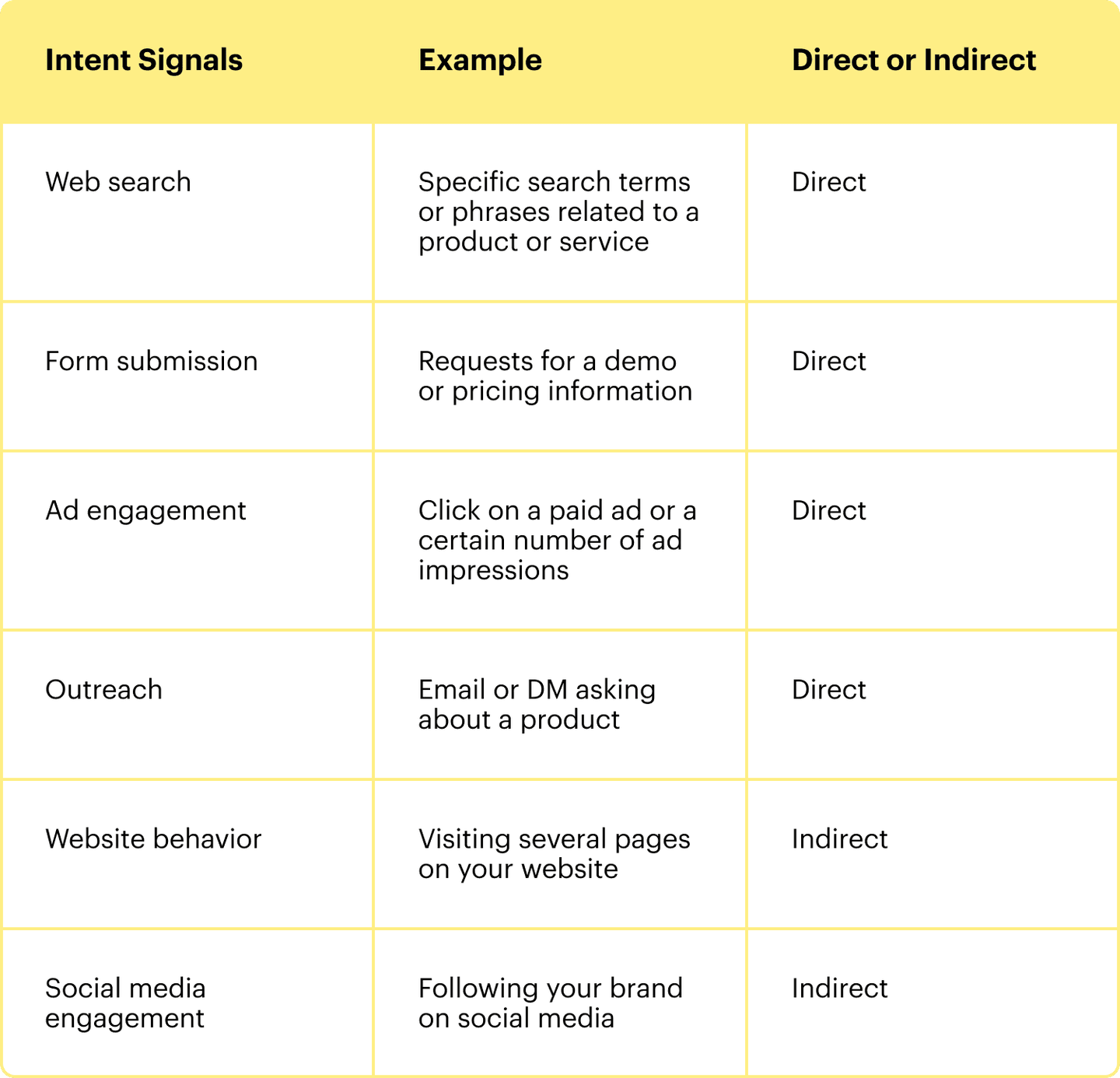
When it comes to B2B marketing and sales, intent signals can further be grouped into account-level intent or the focus of this guide, contact-level intent.
What is contact level intent?
Contact-level intent is an indication or signal that a specific person within a target account has shown interest in a specific product or category.
Any of the intent signals mentioned in the table above can be a contact-level intent signal:
- Website behavior: Bob C. from CocaCola visited your pricing page
- Content consumption: Pat B. from Oracle read a blog post about XYZ
- Ad engagement: Alex L. from Microsoft clicked on your ad
At Influ2, we enable brands to get contact-level intent signals from search, social, ads, and third-party content.
You sync contact lists from your CRM to let us know who you want signals from and the topics that matter to your business. Then, Influ2 tells you when one of those contacts:
- Searches for your topics, even if they don't click through to your website.
- Reads content about your topics on third-party sites.
- Posts about your topics on social media.
We show you exactly who each signal came from.
You can learn more about how it works here.
What’s the difference between contact and account-level intent?
You can think of account-level intent as a less precise version of contact-level intent.
Rather than matching buying signals to an individual, account-level intent aggregates insights gathered from various activities across multiple individuals within a company.
So instead of “Bob from Microsoft clicked your ad about HR software”, you get “Someone from Microsoft is searching for HR software.”
Here’s a table to help understand the difference between the account and contact-level intent:
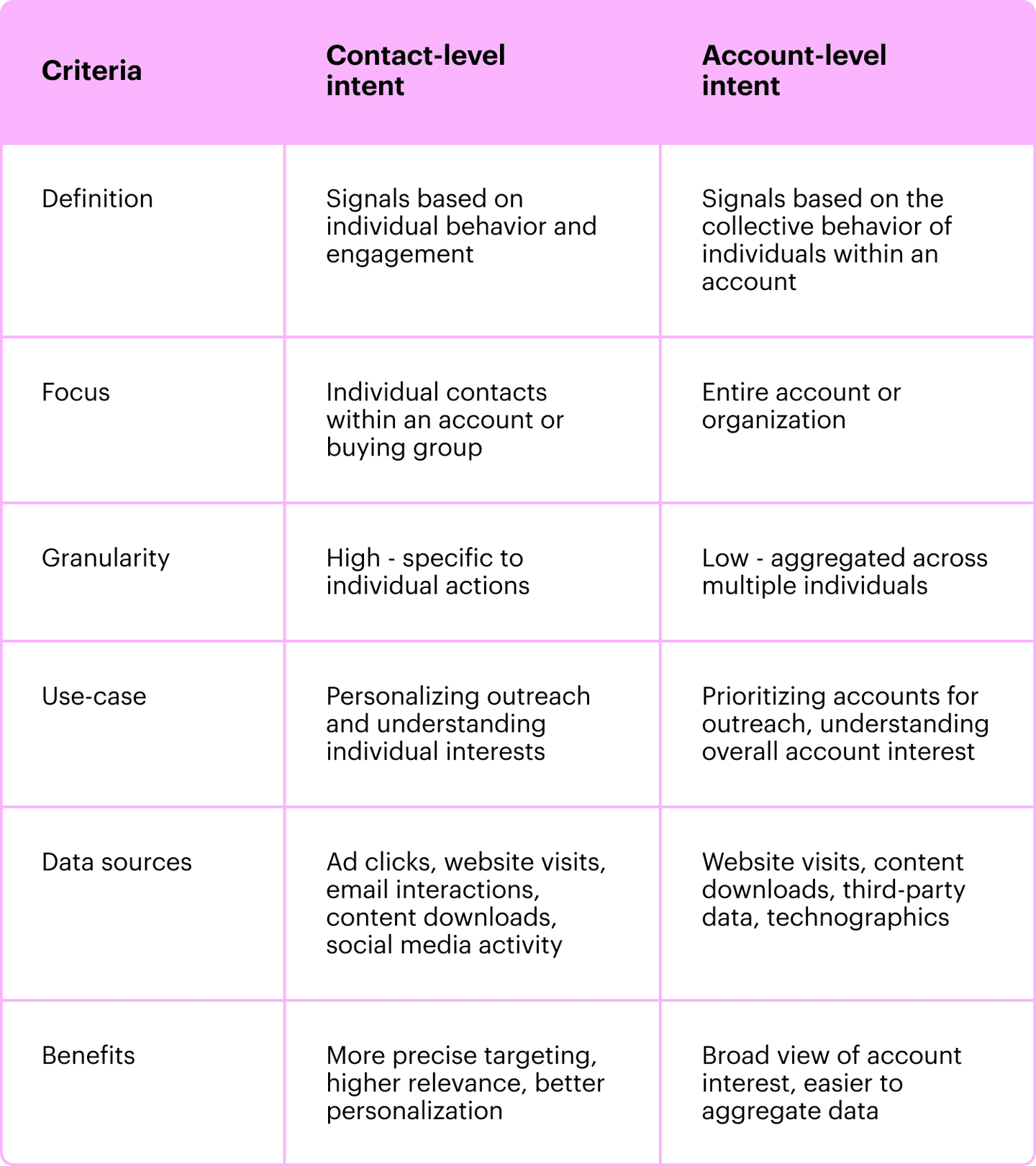
If you don’t know which accounts to target or don’t have a database of prospects, there are ABM tools that can gather account-level insights to point you in the right direction.
The problem though, is a lot of marketers stop at those account-level signals, which isn't helpful for sales. Check out this article to learn why: Contact-Level Intent vs. Account-Level Intent.
Where does contact-level intent data come from?
Contact-level intent signals primarily come from one of two sources:
- First-party intent data is collected by your company (e.g. people who’ve visited your website or clicked on your ads)
- Third-party intent data is collected and aggregated from other sources (e.g. search data or review sites like G2)
Most of the popular ABM tools like 6sense and Demandbase specialize in identifying third-party account-level intent data.
For instance, they can tell you that someone from company X searched for one of your target keywords. Then you need to do additional research to find the exact person, and to understand their search intent.
It’s a limiting process that forces you to be reactive.
At Influ2, we do things differently.
We help create first-party intent signals for the prospects salespeople are actively pursuing. When Sales has a new target prospect, Marketing can start showing them ads to create buying intent signals.
Instead of waiting for a tool to identify buying intent at the account-level, you’re proactively creating buying intent at the contact-level.
Here’s a look at the level of data you get when prospects engage with Influ2 ads.
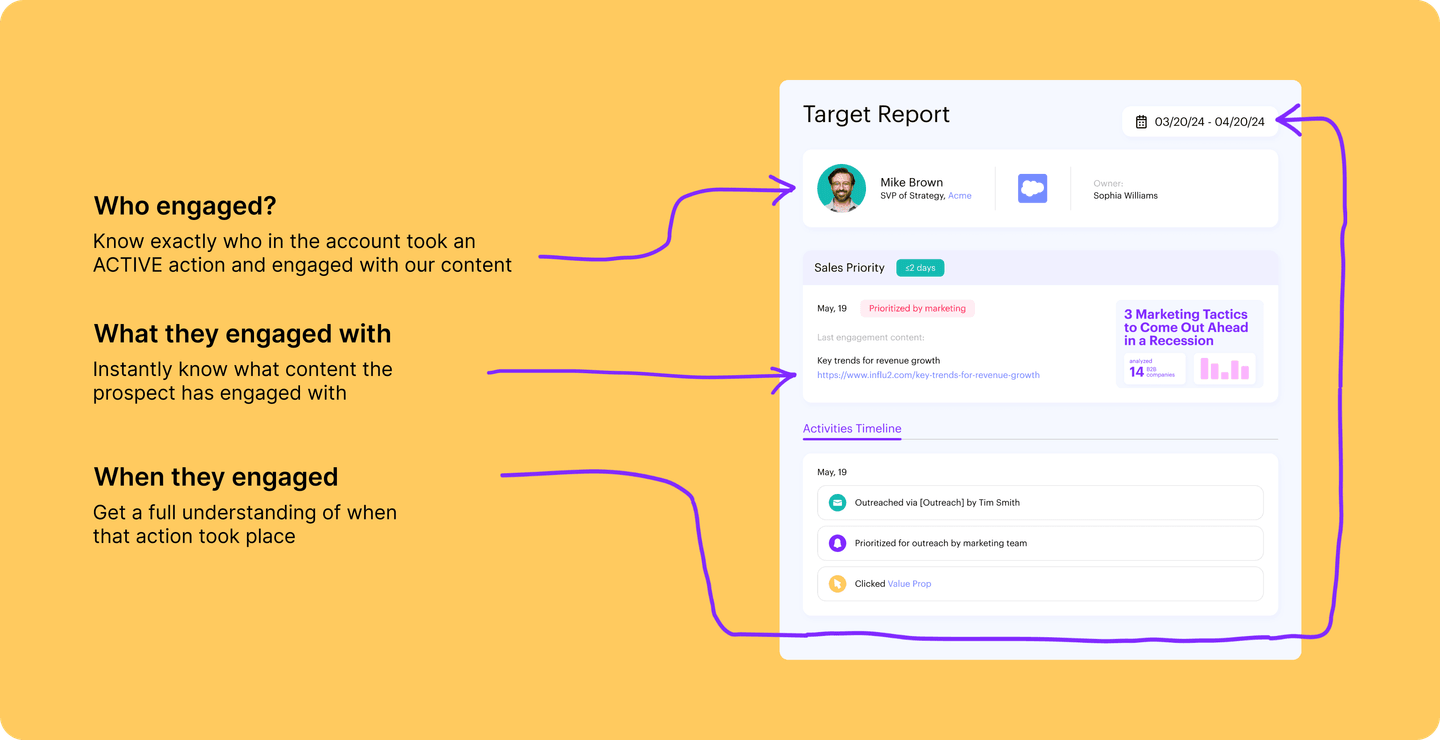
But in addition to that, we also provide many of the same signals traditional ABM tools give you from third parties (search, social, and media sites) but at a contact level.
In other words, we'll show you, "Mike Jones from Microsoft searched {keyword}". While other tools just show you someone from Microsoft is showing intent.
7 ways to maximize contact-level intent signals for sales and marketing
Collecting contact-level intent signals is nice. But unless you turn the data into action, it’s useless.
Here’s how to use contact-level intent signals as a versatile growth lever for marketing and sales.
1. Understand the motivations of each person in a buying group
When you’re targeting larger companies, buying decisions are rarely made by a single person.
You need to convince an entire group of stakeholders (a.k.a. Buying group) to buy whatever you’re selling.
To accomplish this, you need to know:
- Who’s in the buying group
- The needs of each individual within the group
Depending on how your company is structured, your research or sales team will likely be the starting point for who’s in the buying group. But contact-level intent will help you understand each person’s needs and pain points.
Here’s an example.
Say we’re a social media management SaaS company, and we sell to marketing and customer service teams. We’re targeting a fast-growing e-commerce brand for a new account.
Based on our research, we know the buying group consists of:
- Head of Marketing
- Social media manager
- Customer support manager
Our software has use-cases for all of these people, but we need to learn each person’s pain point and match it to our value propositions.
We can create ads for each of our value propositions, show them to the buying group, and monitor who clicks which ad.

Based on the ads each person engaged with, we learn:
- The head of marketing cares about staying within budget and proving ROI.
- The content marketing manager needs an easy way to manage an editorial calendar.
- The social media manager wants to improve how quickly they respond to comments and mentions.
Salespeople can use this information to approach each person within the buying group with targeted messaging instead of sending a generic message to all of them.
Marketers can break each person out into separate buying journeys based on the value proposition they engaged with to serve them more relevant ads going forward.
2. Use engagement data to give your sales team context for outreach
Bland, generic, and impersonal.
If any of those words describe your sales team’s outreach, that’s an instant red flag.
Unfortunately, many sales emails fit this description because salespeople lack the necessary context to create something better.
When you rely solely on third-party account-level intent signals, you’re giving salespeople the same info to “personalize” their outreach as everyone else, so their messages don’t stand out.
Use first-party contact-level intent signals to differentiate your brand.
Going back to the social media SaaS example, we uncovered specific value propositions we can give to our sales team to create targeted emails for each prospect in the buying group.
The simplest way to do this is for them to weave the messaging from the ad each person clicked into the subject line and body of emails or LinkedIn messages.
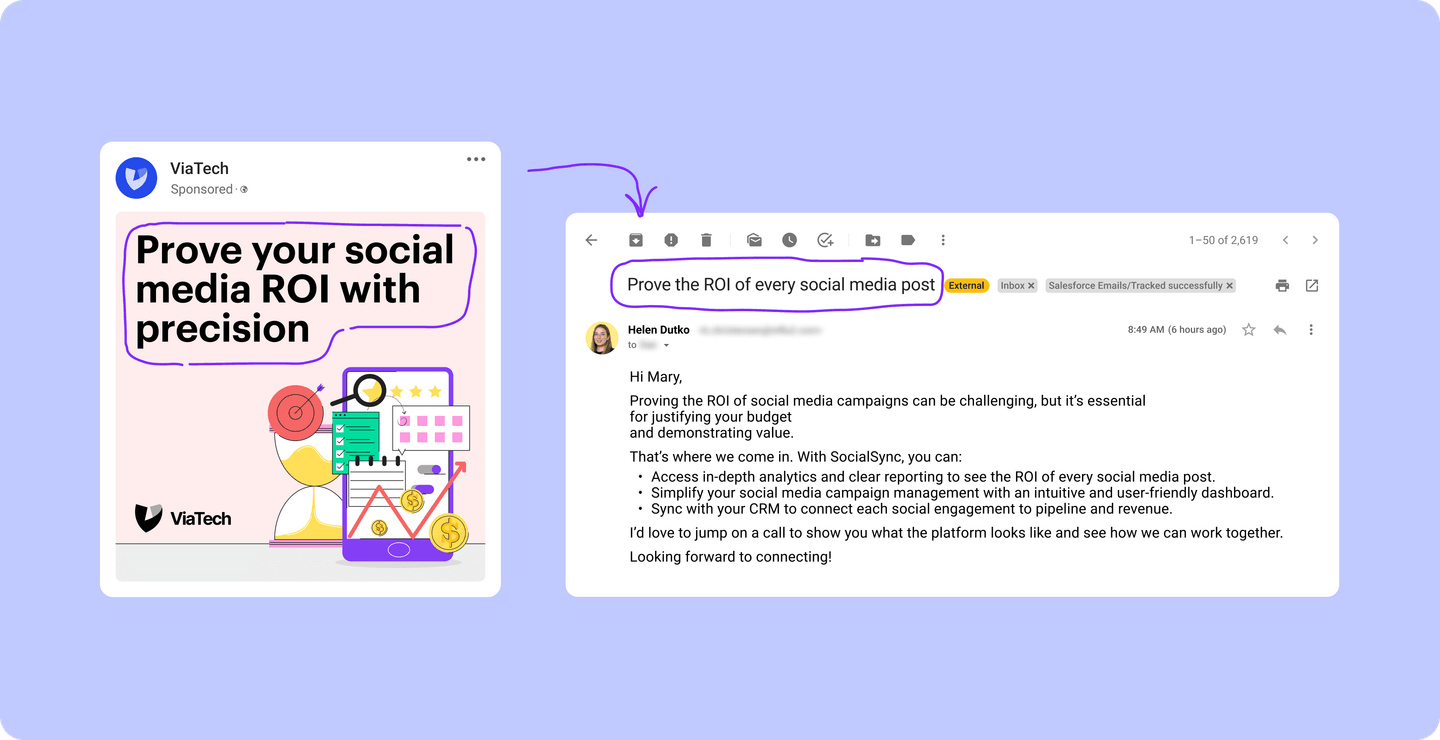
Here’s a tip for your sales team—the outreach should focus on the value proposition that drove prospects to your brand, not the ad engagement itself.
A salesperson letting a prospect know they noticed they clicked on a specific ad four times could creep some people out, which is the opposite of what you want.
3. Help salespeople prioritize their outreach
Salespeople don’t want to spend time chasing down prospects who aren’t ready to buy, and the people they’re repeatedly emailing (with no response) don’t enjoy it either.
As a marketer, you can help salespeople gauge buyer readiness based on the intent signals you’re creating with ads.
Let’s look at how to do it with the help of Influ2.
Say you’re targeting a buying group of 12 people at Warby Parker for your product. Five of those people have clicked at least one ad, while the other seven haven’t engaged at all.
You can automatically pass this data to Sales so they can focus on the five prospects who’ve shown intent rather than chasing down the other seven.
While Sales starts working on the five people who have shown interest, you can continue showing ads to the seven people who haven’t engaged
But it doesn’t stop there.
Once Sales reaches out to the five people who engaged with the first set of ads, you can start showing them a different set of ads since they’re at a different consideration level than the people who haven’t engaged yet.
4. Don’t treat each intent signal the same
A big mistake marketers make with ABM and lead scoring is assuming the same amount of intent no matter what type of content a prospect engages with.
Someone who downloaded an informational ebook shouldn’t be placed in the same bucket as someone who requested pricing information about your product.
For instance, take a look at these two ads.
One is promoting a podcast episode featuring our CEO, while the other is promoting one of our value propositions.
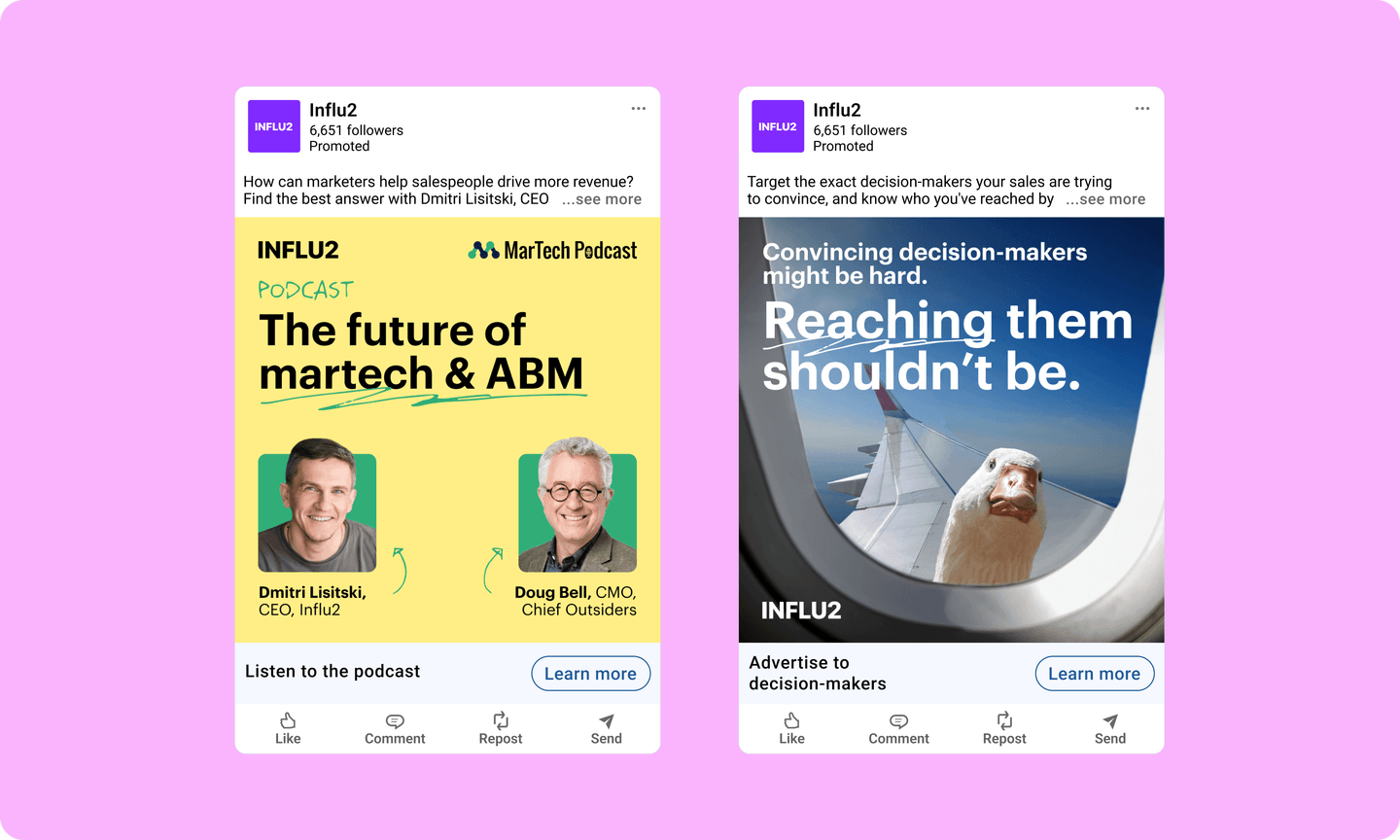
Someone who clicks on the podcast episode has shown interest in a topic relevant to our industry, not our product. Following up to schedule a demo based on this intent signal is premature.
Instead, we can reach out with content on a similar topic, but that’s more middle-of-the-funnel, like a webinar showing how to solve ABM challenges with modern tools, highlighting our product as a solution.
On the other hand, someone who clicked on the value proposition ad has shown more buying intent.
The problem we outlined in the ad resonated with them, so we can follow-up to invite them to a demo or send them a relevant case study.
Let the intent signal dictate the next step you take with a prospect.
5. Act on each buying signal ASAP
There’s an interesting concept in psychology known as the recency effect. It’s our tendency to remember the most recent information we receive best.
For instance, if someone reads you a list of 20 words, you’re more likely to remember the last word on the list than the fifth one.
The recency effect is extremely important when it comes to following up with contact-level intent signals.
The moment someone shows intent (e.g. clicks one of your ads), the clock starts ticking.
Your prospect’s day doesn’t pause when they click your ad. They’ll browse other websites, work on new tasks, scroll social media, and go on with their day.
The longer salespeople wait to contact them, the more the recency effect will start to kick in.
To avoid this, we recommend setting a service level agreement (SLA) with your sales team to contact prospects within 24-48 hours of their engagement with your ads.
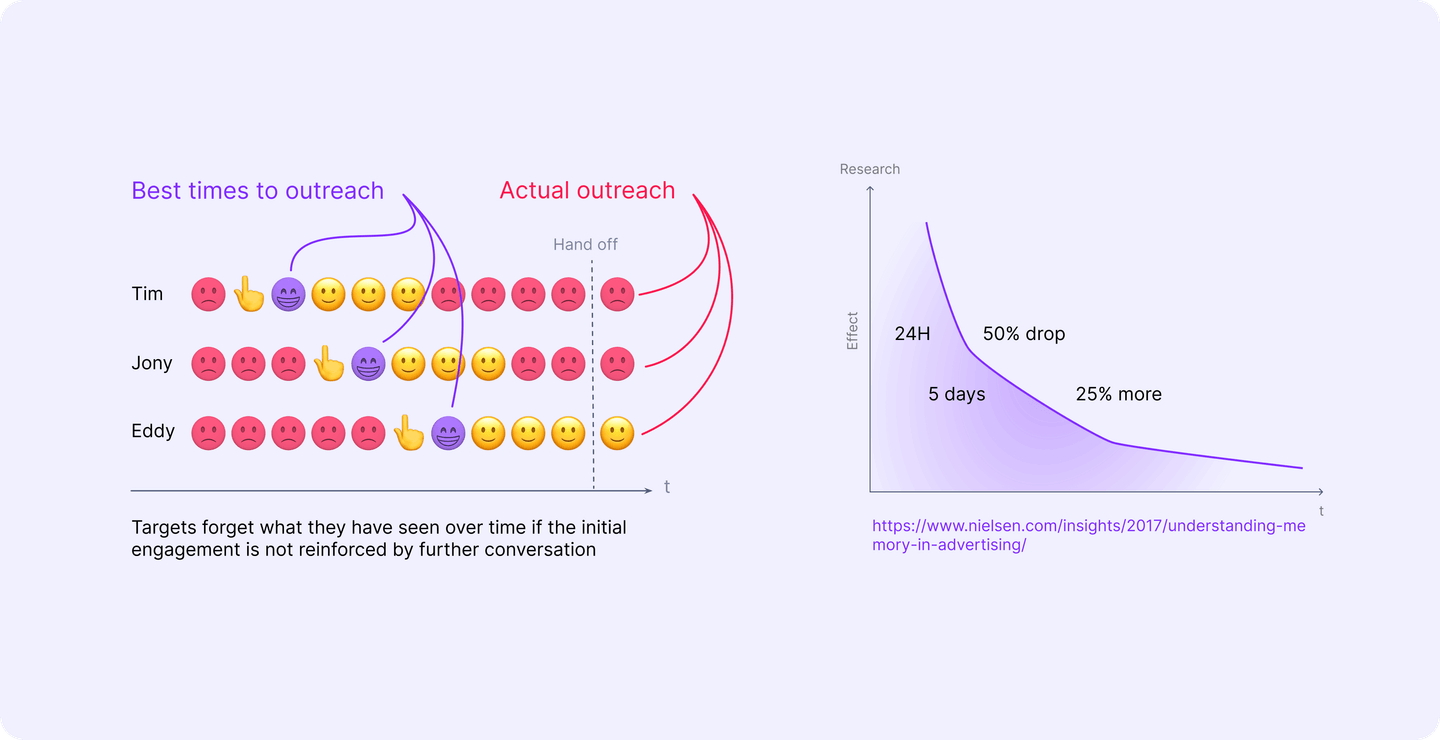
Not only will this help your team take advantage of the recency effect, but it also allows you to strike while the iron’s hot.
The quicker your sales team acts on the intent signals you’re creating, the more likely your campaigns will generate pipeline.
6. Get smart with automation
The best way to make sure sales can act on intent signals quickly is with automation.
Whenever a prospect clicks an ad or has another intent signal, your sales team needs to be notified immediately (remember the recency effect).
With Influ2, you can trigger notifications to Sales based on how prospects engage with your ads.
For instance, Sales should be notified if someone clicks an ad or reaches a certain number of impressions.
Once the trigger event happens, the salesperson assigned to the prospect receives a notification containing:
- Who clicked the ad
- Which ad they clicked
- A link to the landing page they saw
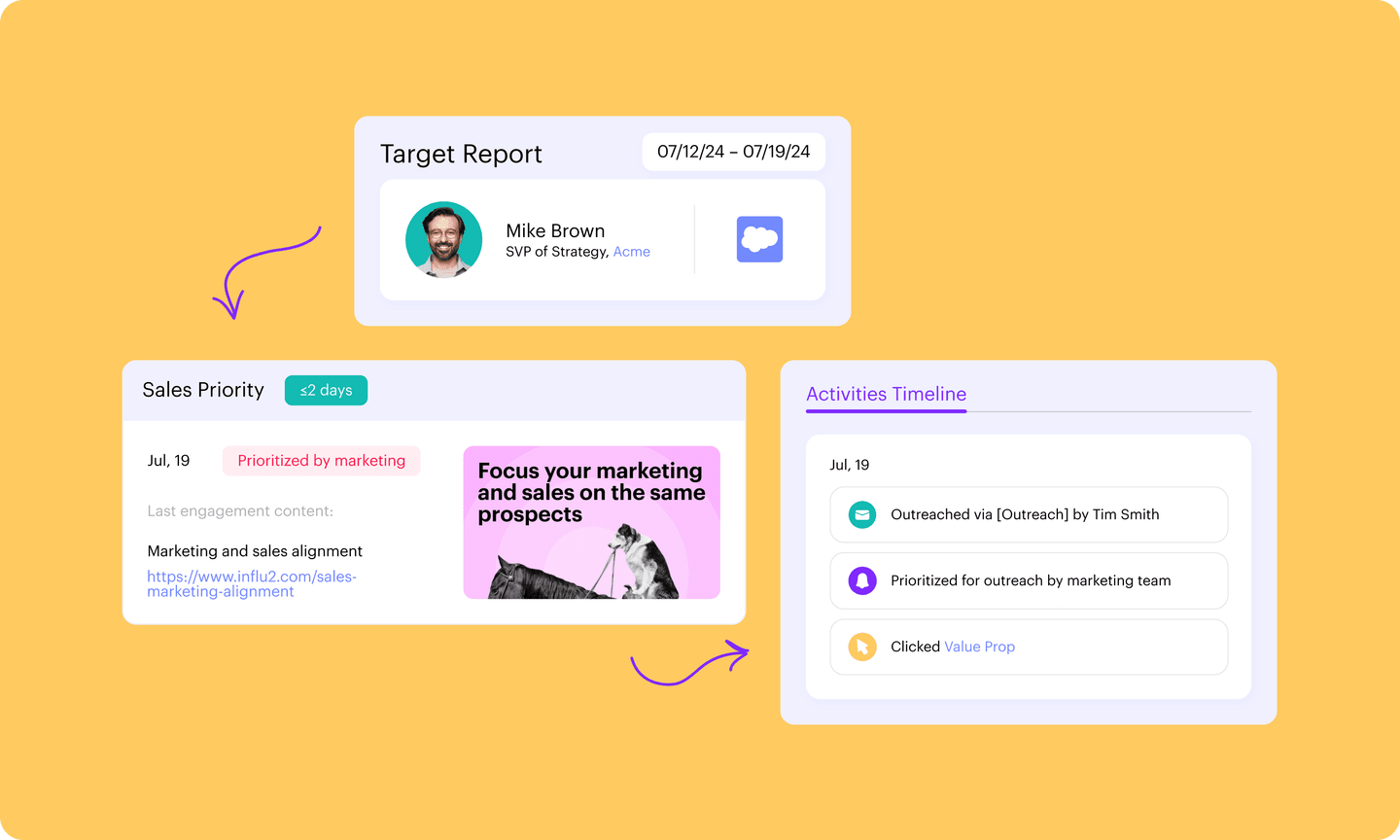
There are plenty of other things you can automate as well, such as updating which ads prospects see based on their sales stage in your CRM or how much they engage with ads.
If you’re interested in learning more, let us know!
7. Measure marketing’s total influence on pipeline and revenue
Attribution is one of the messiest and most heavily debated topics in the sales and marketing world.
No matter where you stand on the issue, one thing is clear: marketers want a better way to measure the full impact of their campaigns.
Contact-level intent helps solve that (if you use Influ2).
With Influ2, every time a target prospect clicks your ad or has a certain number of ad impressions, marketing is credited with influencing the deal. We then tie that influence to pipeline and revenue.
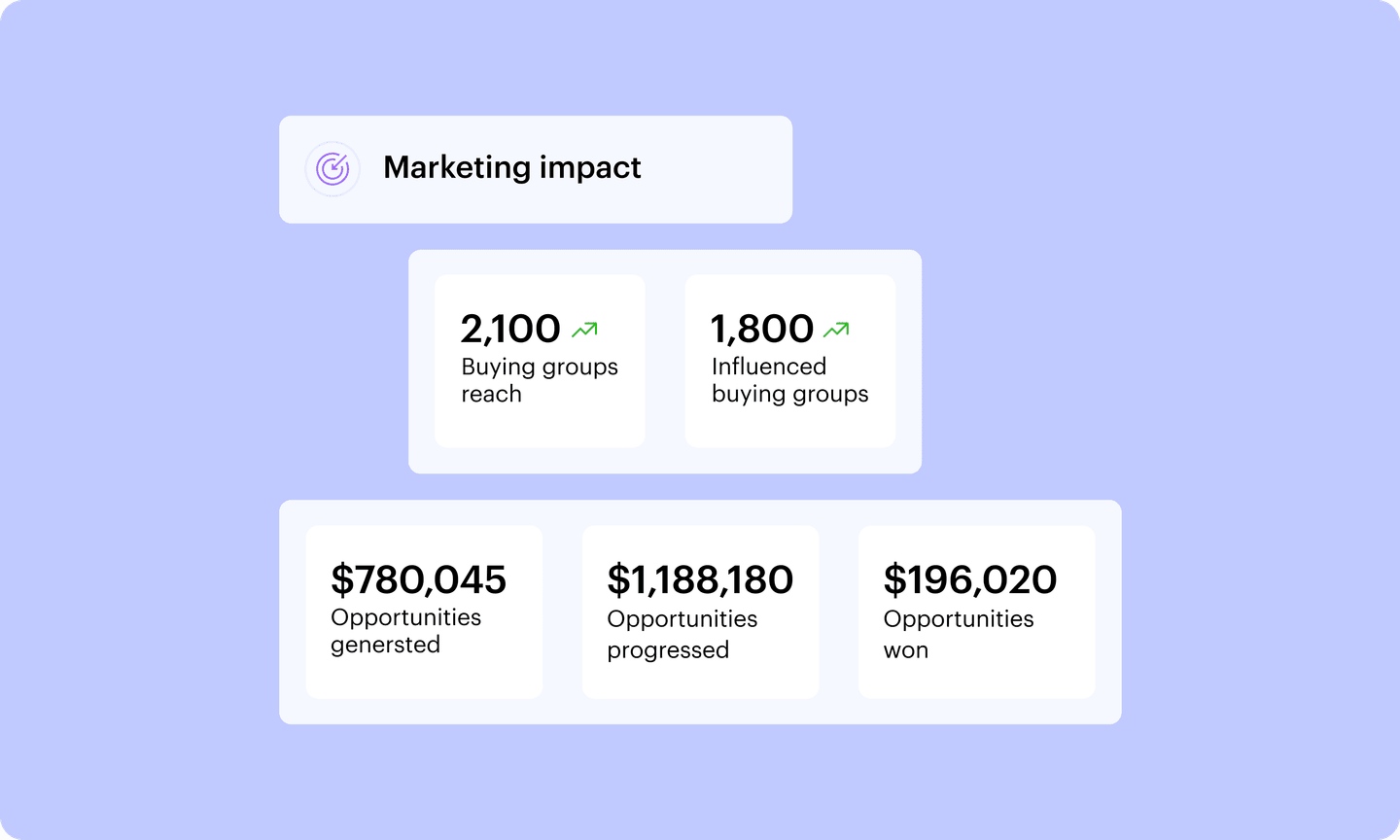
This is significant for measuring ROI of your campaigns and marketing’s impact on won deals.
Contact-level intent changes the way you engage and convert prospects
Whether you’re completely new to intent-based advertising or you want to get better results from your current ABM campaigns, contact-level intent should be part of your strategy.
If this guide piqued your interest, here are the next two things you should do:
- Check out these examples of companies crushing it with contact-level intent
- Get in touch with us to learn more







